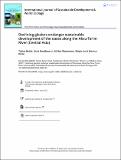Declining glaciers endanger sustainable development of the oases along the Aksu-Tarim River (Central Asia)
Abstract
Tarim River basin is the largest endorheic river basin in China. Due to the extremely arid climate the water supply solely depends on water originating from the glacierised mountains with about 75% stemming from the transboundary Aksu River. The water demand is linked to anthropogenic (specifically agriculture) and natural ecosystems, both competing for water. Ongoing climate change significantly impacts the cryosphere. The mass balance of the glaciers in Aksu River basin was clearly negative since 1975. The discharge of the Aksu headwaters has been increasing over the last decades mainly due to the glacier contribution. The average glacier melt contribution to total runoff is 30–37% with an estimated glacier imbalance contribution of 8–16%. Modelling using future climate scenarios indicate a glacier area loss of at least 50% until 2100. River discharge will first increase concomitant with glacier shrinkage until about 2050, but likely decline thereafter. The irrigated area doubled in the Aksu region between the early 1990s and 2020, causing at least a doubling of water demand. The current water surplus is comparable to the glacial runoff. Hence, even if the water demand will not grow further in the future a significant water shortage can be expected with declining glacial runoff. However, with the further expansion of irrigated agriculture and related industries, the water demand is expected to even further increase. Both improved discharge projections and planning of efficient and sustainable water use are necessary for further socioeconomic development in the region along with the preservation of natural ecosystems.
Citation
Bolch , T , Duethmann , D , Wortmann , M , Liu , S & Disse , M 2022 , ' Declining glaciers endanger sustainable development of the oases along the Aksu-Tarim River (Central Asia) ' , International Journal of Sustainable Development and World Ecology , vol. 29 , no. 3 , pp. 209-218 . https://doi.org/10.1080/13504509.2021.1943723
Publication
International Journal of Sustainable Development and World Ecology
Status
Peer reviewed
ISSN
1350-4509Type
Journal article
Description
The study is based on results of the project Sustainable Management of River Oases along the Tarim River (SuMARiO) supported by the German Ministry of Science and Education (Bunderministerium für Bildung und Forschung, BMBF, Code 01 LL0918 A-K).Collections
Items in the St Andrews Research Repository are protected by copyright, with all rights reserved, unless otherwise indicated.

